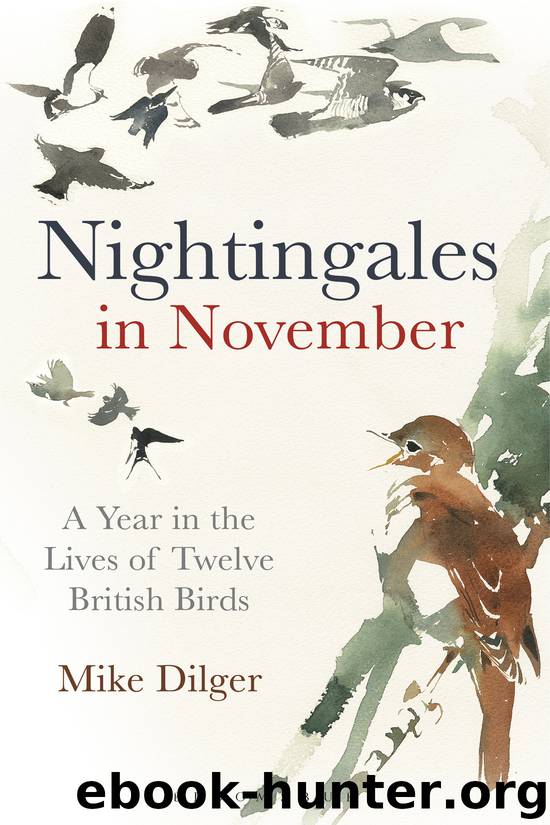Nightingales in November by Mike Dilger

Author:Mike Dilger
Language: eng
Format: epub
Publisher: Bloomsbury Publishing
Safely ensconced underground, once the Puffin chick reaches around a week old, it should be able to maintain its body temperature well enough so that it can be left unsupervised while both parents are out fishing. The adults never bring food in at night, and there is also a very pronounced rhythm to when fish are delivered, with a high frequency of feeds in the morning, a tailing off during the middle of the day and a resurgence again in the evening. These pronounced peaks and troughs may well be due to the behaviour of the fish that are being exploited by the Puffins, with Sandeels more actively feeding in the water column in the morning and fish like Sprats rising closer to the surface at dusk. Once the morning’s fishing gets under way, the traffic of birds flying to and fro can be very clearly seen at large puffinries, with the adults frequently returning like geese in a ‘V’ formation to deliver sustenance to their waiting chicks. Once the food has been dropped off, the parent will often not fly back out to sea immediately, but use this brief period of respite to glean from other Puffins valuable information, not just about the directions leading to the best fishing areas, but also the type and quantity of food being brought in.
The frequency of feeds during the course of the day will depend on how far the parents are foraging out to sea and the availability of food, but generally most chicks will receive anywhere between three and eleven feeds in a day, with four to six mealtimes being most common. When younger, the Puffling would have been carefully fed beak to beak by its parents, but as it develops, the parents may confine visits to simply dumping the catch on the floor of the burrow and leaving the youngster to waddle down in order to feed itself. The chicks are able to put away a surprisingly large amount of food, and seem to have no problem in polishing off every last morsel brought in by their parents. When not eating or sleeping, the growing Puffling will also become much more mobile underground and spend an increasing amount of time preening, scratching and playing with any nesting material close by. The period when the young hatch also seems to coincide with a small window of time when a few of the two- and three-year-olds from previous breeding seasons pay the colony a visit. Too young to breed and presumably dropping in just to conduct a reconnaissance, these adolescents with their dusky faces and thin bills will often stand out like sore thumbs amongst the throng of adults in all their breeding finery.
Download
This site does not store any files on its server. We only index and link to content provided by other sites. Please contact the content providers to delete copyright contents if any and email us, we'll remove relevant links or contents immediately.
The Lonely City by Olivia Laing(4571)
Animal Frequency by Melissa Alvarez(4156)
All Creatures Great and Small by James Herriot(3988)
Walking by Henry David Thoreau(3685)
Exit West by Mohsin Hamid(3636)
Origin Story: A Big History of Everything by David Christian(3473)
COSMOS by Carl Sagan(3352)
How to Read Water: Clues and Patterns from Puddles to the Sea (Natural Navigation) by Tristan Gooley(3241)
Hedgerow by John Wright(3109)
How to Do Nothing by Jenny Odell(3103)
The Inner Life of Animals by Peter Wohlleben(3100)
How to Read Nature by Tristan Gooley(3080)
Project Animal Farm: An Accidental Journey into the Secret World of Farming and the Truth About Our Food by Sonia Faruqi(3019)
Origin Story by David Christian(2994)
Water by Ian Miller(2955)
A Forest Journey by John Perlin(2918)
The Plant Messiah by Carlos Magdalena(2750)
A Wilder Time by William E. Glassley(2690)
Forests: A Very Short Introduction by Jaboury Ghazoul(2671)
